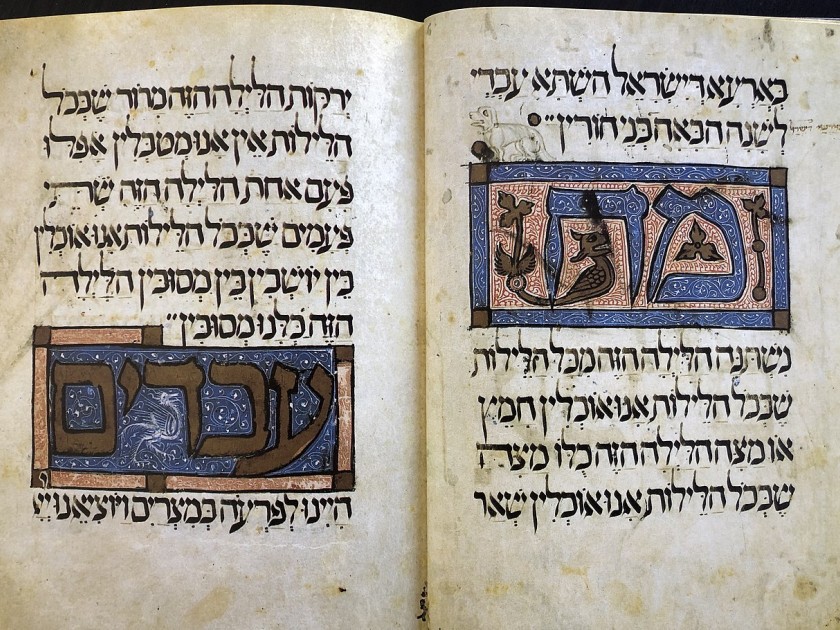
The Four Questions from the Sarajevo Haggadah illuminated manuscript circa 1350
As surely as crocuses bloom in the spring, so too does a new crop of Haggadot. In her spritely biography of the Haggadah, Vanessa L. Ochs, a professor of religion at the University of Virginia, notes that many contemporary editions have reworked the text, and several 2020 Haggadot nicely illustrate that trend. These Haggadot, as well as Ochs’ history, will enrich any seder with topics ranging from the Exodus from Egypt to today’s headlines, thus emphasizing the enduring message of Passover.
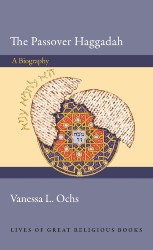
The Passover Haggadah: A Biography
“And you shall tell your son on that day….” This simple command in Exodus has led to more than five thousand versions of the Passover story. Ochs recounts its life beginning with various mentions in the Bible and ending with the profusion of Haggadot today; these variations reflect the geographical spread of Jewish communities, the diversity of practice, and historic events. For anyone interested in the emergence and complex evolution of the Haggadah, this biography offers a trove of information in engaging and inviting language.
The biblical mentions range from the original Passover, preceding the flight from Egypt, to the extravagant festivities celebrated at the Temple in Jerusalem under the kings Hezekiah and Josiah; there are no rituals described for these celebrations. In response to the destruction of the Temple in 70 CE, the rabbis struggled to create practices that would preserve the holiday and its significance; their transmittal was entirely oral, but their discussions and rituals were eventually recorded in the Mishnah and Tosefta, which have brief descriptions of the home ceremonies that took place in the first decades after the destruction.
By the eleventh century, texts from the centers of Jewish learning were consolidated in a recognizable Haggadah and adopted throughout the Jewish world — augmented by regional ritual. By the medieval period a Haggadah for family use was coming into use, and with it the desire to enhance the holiday (hiddur mitzvah), giving rise to elaborately illustrated and illuminated Haggadot commissioned by rich families.
The advent of printing gave rise to a robust market for Haggadot and made it possible to own multiple copies and replace overused ones. Notable editions featured such attractions as translations into the vernacular to accompany the Hebrew text, and commentary as well as illustrations, explanations, and instructions.
The next major innovation came in the nineteenth century, when Reform Judaism and the kibbutz movement further energized the creation of Haggadot reflecting new mind sets and approaches to Judaism; however, this burst of ideologically inspired Haggadot was overshadowed by World War II and the Holocaust. Notable Haggadot of the wartime period include the lavishly illustrated edition by the artist Arthur Szyk linking the Jewish slaves in Egypt to the persecuted Jews of Europe, and versions created for those who served in the war. The question of how to memorialize the Holocaust within the Haggadah continues to be relevant when creating postwar Haggadot.
Which brings us to the publication today of Haggadot, and the question of why we keep revising the Haggadah after centuries of use. In the closing of the biography, Ochs critiques the flaws and the value of the Haggadah and concludes that the final pages of its life are yet to be written.
The Passover Haggadah is a volume in the Lives of Great Religious Books published by the Princeton University Press.
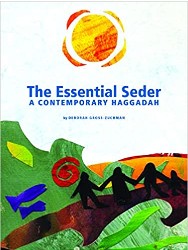
The Essential Seder: A Contemporary Haggadah
The Haggadah is compiled by Deborah Gross-Zuchman, a painter whose colorful illustrations enliven the text; Gross-Zuchman’s Haggadah is framed as a short and meaningful seder, with fresh language and a contemporary sensibility that emphasizes social justice. It follows the order of the seder and the blessings and other familiar sections are in Hebrew with English transliteration, the body of the text is in English. Discussion, prompted by questions about freedom and justice, is the dinner table conversation. For those brought up on the traditional text, the updated language may be a a fruitful change, or a bit disorienting. The Four Children, for example, are cast as different aspects of our inner selves; the Magid is a notable departure, centered on Moses, who does not appear in the traditional telling.
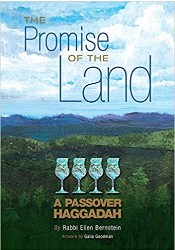
The Promise of the Land: A Passover Haggadah
Not every Haggadah comes with an endorsement by the environmentalist Bill McKibben, but this edition celebrates the natural world and its significance in our lives as we come together to celebrate Passover. It is intended for both knowledgeable and unfamiliar participants. The traditional text, largely in English, is printed in green; ecological commentary, context, and sidebars, emphasizing nature and the land, are printed in black and are intended to encourage discussion. An interesting inclusion in this Haggadah are the last two verses of the Magid (Deuteronomy 26:9 – 10), omitted in the traditional text: “Adonai…gave us this land,” a significant message for this ecological retelling. In a brief discussion the author explores the reasons for the omission and the importance of their inclusion here. The illustrations by Galia Goodman enrich the texts.
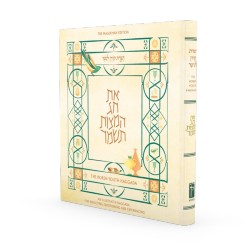
This lovely Haggadah from Israel beautifully fulfills the command, “And you shall tell your child on that day…” Educational in the finest sense of the word, on each page the Haggadah has the Hebrew text and an age-appropriate translation; a lively full-color illustration; an instruction to explain what is happening; an activity; an idea or quotation to reflect on; and a question for discussion. Along the bottom of each page is a navigation bar indicating where the readers are in the service. A Parent and Educator Companion is available on the publisher’s website; it not only takes the leader through the Haggadah page by page, expanding the explanations and suggesting answers to the many questions the Haggadah poses, but also explains many of the illustrative and iconic elements. Even with all the activity on each double-page spread, the Haggadah is very well designed, and the pages are open and inviting.
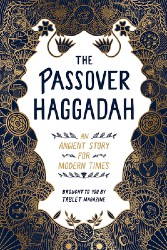
The Passover Haggadah: An Ancient Story for Modern Times
The subtitle describes this Haggadah perfectly. It is the most traditional of the Haggadot reviewed here — the complete Hebrew text, both translated and transliterated — with a thoughtful and wide-ranging introduction and three reflective essays. And all this served up with the Tablet edge — tradition laced with questioning, sly humor, and an ultra-contemporary sensibility. A good example is the seder plate, illustrated with a classic setting accompanied by a bar along the bottom of the page suggesting six possible additions representing everything from the just-about- traditional orange to a pine cone for criminal justice reform. There are four daughters to complement the four sons (three of whom are old enough to sport a mustache). If a leader finds the text lagging a little, there are occasional alerts on how to skip ahead or try a diversion.
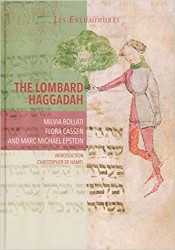
The Lombard Haggadah takes its place in the collection of outstanding facsimiles of rare medieval Haggadot. The first stand-alone Italian Haggadah — one that is not part of a siddur — it dates to the fourteenth century. Reproduced in a handsome large-format volume for study and appreciation, it includes essays by leading scholars on Jewish life in Lombardy, the artistic sources and inspiration of the Haggadah, and the meanings and ambiguities in the illustration. For the lay reader the delicately beautiful art, appearing on almost all of the seventy-five pages, are reward enough, showing the dress, environment, household life of the Jewish Lombard community, and influence of Christian art. The entire Haggadah is reproduced in the closing section; in addition to the seder, the volume includes a few stories from Genesis and Exodus, and a catalogue of monthly labors akin to a book of days.
Maron L. Waxman, retired editorial director, special projects, at the American Museum of Natural History, was also an editorial director at HarperCollins and Book-of-the-Month Club.